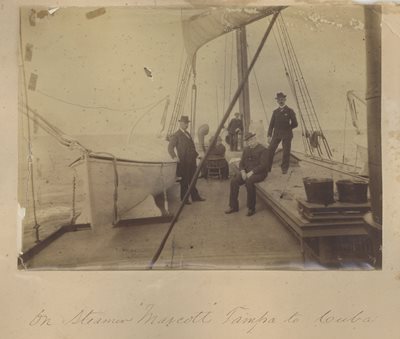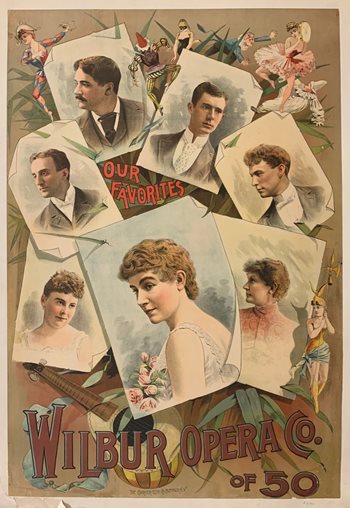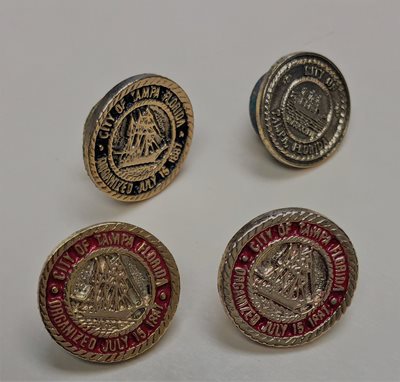Lucky Charms: An Opera, a Steamship, and Tampa’s Civic Identity
Soprano Katie Terres and tenor Dylan Glover perform “The Gobble Duet,” the most popular song from Edmond Audran’s comic opera The Mascotte. Dr. Rodney Shores provides piano accompaniment. (Videographer: Troy Cusson) Watch as the young shepherd Pippo and Bettina, a farm girl who tends turkeys, discover that their love for one another exceeds their devotion to their animals.
SYNOPSIS
Translated into English, The Mascotte tells the story of the fair maiden Bettina, who was born a “mascotte.” According to legend, a mascotte is a magical being who brings luck to everyone around her so long as she remains chaste and unwed. Comedy ensues from the antics of Prince Laurent, who conspires to keep Bettina from her true love, the shepherd Pippo. The lovers are eventually reunited, and we learn that her magical gift will be inherited by their children.
A LUCKY BREAK

On Steamer Mascotte, Tampa to Cuba, Henry Plant Museum Archives
In late 1885, Margaret Plant, the wife of railroad and shipping magnate Henry Plant, christened his new steamship the Mascotte. She hoped that the name would bring the same good luck depicted in the comic opera. Thirty feet wide and 215 feet long, the S.S. Mascotte boasted hardwood interiors and accommodations for 50 first-class passengers. Soon, the vessel connected the ports of Tampa, Key West, and Havana. It carried mail, cargo, and people to support the development of Ybor City and West Tampa. During the War for Cuban Independence in the late 1890s, the S.S. Mascotte and its sistership the S.S. Olivette brought sufficient tobacco to Tampa to protect the city’s cigar industry from a Spanish embargo.
When the new vessel slid, without accident of any kind, gracefully into the water, Mrs. Plant broke a bottle of wine across the bows and, amid three hearty cheers, christened her the Mascotte.
The above quote is from the Philadelphia Times, Oct. 23, 1885, p. 4.

Wilbur Opera Company Poster, 1895, Private Collection.
Edmond Audran’s comic opera remained popular in Tampa at the turn of the century. Following the opening of the Casino on the grounds of the Tampa Bay Hotel in 1896, the 2000-seat auditorium witnessed multiple productions of The Mascotte by the Wilbur Opera Company and other theatrical troupes. Although the Casino rivaled the period’s finest metropolitan opera houses, Tampa residents eschewed the grand foreign-language operas that were redefining high-brow culture in New York. Instead, they demanded encore performances of The Mascotte, other European comic operas performed in English, and Gilbert and Sullivan operettas. Audiences delighted in The Mascotte’s far-fetched plot, comic antics, elaborate costumes and sets, and the attractiveness of scantily clad chorus girls.
In the last act [of the Mascotte] the grand march by a chorus of twenty beautiful girls is one of the prettiest things in the opera.
The above quote is from the Tampa Weekly Tribune, Jan. 23, 1898, p. 4.
The Mascotte resonated on a deeper level in Tampa. In the 1890s, the city was a community of migrants in a place that was undergoing rapid growth and change. The comic opera offered a comforting celebration of childhood homes and simpler times. In the following video, soprano Katie Terres and pianist Dr. Rodney Shores perform "How of My Village," the song from The Mascotte that became synonymous in popular culture with the virtues of hometowns. (Videographer: Troy Cusson)
As for Henry Plant’s lucky steamship, the
S.S. Mascotte was incorporated into Tampa’s city seal. In 1895, cigar box manufacturer Henry Leiman received permission from the Tampa City Council to add the seal to his boxes, and it quickly became one of the country’s most well-known city symbols. Since at least the 1920s, though, the historical inaccuracies in the representation of the vessel have attracted criticism. The seal depicts the
S.S. Mascotte as a sailing ship rather than a steamship. Regardless, the ship named for a comic opera continues to shape Tampa’s civic identity.
 Tampa City Seal Lapel Pins, City of Tampa Archives
Tampa City Seal Lapel Pins, City of Tampa Archives
FURTHER READING:
Seth Bramson, “A Tale of Three Henrys,”
The Journal of Decorative and Propaganda Arts 23 (1998), 112-143.
Edward A. Mueller,
Steamships of the Two Henrys: Being an Account of the Maritime Activities of Henry Morrison Flagler and Henry Bradley Plant (1996).
Katherine Preston,
Opera for the People: English-Language Opera and Women Managers in Late Nineteenth-Century America (Oxford Univ. Press, 2017).
Arsenio M. Sanchez, “The Olivette and Mascotte of the Plant Steamship Line,”
Sunland Tribune 20 (Mueller, 1994).
Kristen M. Turner,
Opera in English: Class and Culture in America, 1878-1910 (Ph.D. dissertation, Univ. of Chapel Hill, 2015).
Written by Dr. Charles McGraw Groh. Learn more about the history of popular entertainment in his presentation,
"Plant's Follies: The Casino and Tampa's Civic Identity."